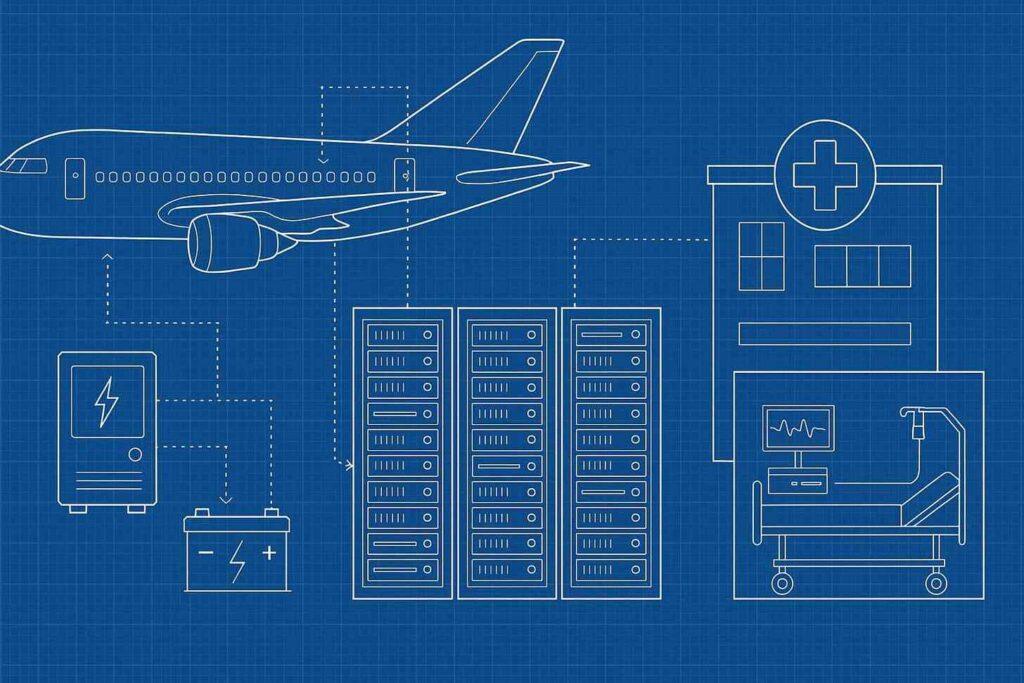NASA engineers, airline pilots, and Amazon Web Services all use the redundancy mental model. This strategy creates hidden safety nets in complex systems. It helps you deal with failures calmly, whether it’s in aircraft design, cloud management, or everyday life.
This approach isn’t about waiting for disaster. It’s about being ready for it. It’s a way to prepare for the unexpected without losing your cool.
This framework helps you think like engineers who design bridges with extra supports or pilots who train for emergencies. You already use versions of it daily: keeping a spare key, saving work drafts, or packing snacks for a road trip.
The goal? Reduce single points of failure quietly, without overcomplicating things.
Why does this matter? Systems fail. Plans change. But when you apply this approach, you’re not just reacting—you’re ready. Think of it as a tool for peace of mind. Those who use it sleep better, work smarter, and stay calm when others panic.
Key Takeaways
- Prepares you for unexpected problems by planning backups
- Used in high-stakes fields like aviation and tech
- The redundancy mental model reduces anxiety by eliminating single failure points
- Works through simple questions like “What’s my Plan B?”
- Transforms how you handle careers, relationships, and daily tasks
Ready to make this thinking style second nature? Let’s explore how the redundancy mental model turns everyday risks into manageable puzzles.
Understanding the Redundancy Mental Model
What if your main route to work closed today? Would you have alternatives ready? This approach acts like guardrails on a mountain road—invisible until needed, but vital when things in the world go sideways.
It’s about designing systems that keep functioning even when parts of the data break down.
Safety Nets in Action
Critical operations use layered protection for good reason. Hospitals run backup generators during storms. Data centers mirror information across continents. These aren’t luxuries—they’re lessons from hard experience. The process involves asking one question repeatedly: “How bad would this hurt if it failed?”
When Failure Isn’t an Option
In control towers and emergency rooms, single mistakes can cascade. That’s why teams build multiple checks into their workflows. Pilots cross-verify instruments. Surgeons confirm patient details aloud. This theory transforms “hoping nothing breaks” into “knowing you’re covered.”
The best plans embrace human nature. We forget. We miscalculate. Backup strategies compensate for these realities. They turn potential disasters into manageable hiccups—like having a flashlight during blackouts or extra cash in your glovebox.
Types of Redundancy: Hardware, Software, and Human
Redundancy strategies come in three main types: hardware, software, and human. Hardware redundancy includes systems like multiple engines or backup generators. Software redundancy uses mirrored databases or fallback algorithms in AI systems.
Human redundancy involves having additional staff trained to step in during emergencies, such as pilots or surgical teams that cross-check each other.
Each type covers different failure modes, creating overlapping protection. Combining them enhances reliability even more—for instance, using both automated alerts and manual checks in industrial control systems.
How the Redundancy Mental Model Works in Critical Systems

The redundancy mental model comes from systems engineering. It’s about having backup processes to keep things running even when they fail. This idea is key in fields like aviation, healthcare, military operations, and IT.
For instance, airplanes have many safety features. They have separate hydraulic lines and two navigation systems. This ensures they can keep flying even if something goes wrong.
In cybersecurity, having extra servers helps protect data from being lost. In hospitals, having two oxygen systems in ICUs is a safety net. The main idea is to make systems strong and reliable by avoiding single weak points.
Real-World Applications in Aviation

Have you ever wondered why flying feels routine despite its complexity? Modern aircraft hide layers of backup plans within their design. Commercial planes serve as one of the clearest examples of strategic preparation in the world of aviation.
Every critical component has alternatives ready to activate, a part of the model that reflects advanced thinking and the study of human factors.
Multiple Engines and Control Systems
Twin-engine jets can lose half their power yet stay airborne. Four-engine planes handle multiple engine failure while maintaining flight paths. Hydraulic systems follow the same logic: if primary controls malfunction, secondary systems engage instantly.
| Primary System | Backup Systems | Performance Impact |
|---|---|---|
| Engines | 2-4 independent units | 50-75% thrust retention |
| Hydraulics | Triple redundant lines | Zero control loss |
| Navigation | GPS, radio, inertial guides | Continuous positioning |
Case Study: How Airplanes Stay Airborne
Two pilots monitor every flight – a human backup layer. When one’s ability to operate diminishes, the other takes command. Navigation tools overlap too: GPS coordinates cross-check with ground-based signals and onboard sensors.
This multi-layered approach explains aviation’s safety record. Planes withstand failures that would ground other vehicles because their work processes assume things might break. Passengers rarely notice these silent safeguards – until they’re needed.
Redundancy in NASA’s Apollo Missions

What does it take to survive a crisis 200,000 miles from Earth? NASA’s Apollo program found out through safety and creativity.
Their spacecraft had backup plans inside other backup plans. This strategy turned possible disasters into victories. It shows us how to be resilient in our own world.
When Backup Plans Become Lifelines
The 1970 Apollo 13 mission shows how preparation meets opportunity. An oxygen tank explosion disabled primary systems, but engineers repurposed the lunar module as a temporary habitat. This unplanned “lifeboat” had independent power and air filters – resources never meant for this use.
Ground teams solved problems using manuals written for dozens of failure scenarios. They jury-rigged carbon dioxide scrubbers with spare parts. Navigation experts used the sun’s position to guide the crew home when normal systems failed.
This event proved backup strategies need flexibility, not just duplication. NASA’s approach influenced modern space stations and Mars rovers. Engineers now design systems with multiple failure paths in mind.
Could your plans withstand unexpected blows? Apollo 13 teaches us that survival often depends on creative use of alternatives. Having options matters more than hoping nothing breaks.
Redundancy in Technology and Cloud Services

How often do you think about what keeps your favorite apps running during a storm? Behind every seamless online experience lies a hidden web of backup systems that are a crucial part of the process.
Modern technology treats failure as inevitable—and in this thinking, it models performance to ensure swift response to any disruptions.
Amazon Web Services and Regional Safeguards
Amazon Web Services (AWS) reshaped how the world handles digital infrastructure. Their network spans 33 geographic regions, each with multiple data centers. If one facility fails, traffic shifts instantly to others—like rerouting highway cars during a road closure.
Streaming platforms showcase this approach. When you watch a movie, your device connects to the nearest available server. If that location goes offline, another takes over without buffering. This happens thousands of times daily, invisible to users.
| Service Provider | Redundancy Feature | Uptime Guarantee |
|---|---|---|
| AWS | Multi-AZ deployments | 99.99% |
| Google Cloud | Global load balancing | 99.95% |
| Microsoft Azure | Geo-redundant storage | 99.9% |
Critical information gets copied across continents. Bank transactions replicate in real-time to servers in different countries. Even if an earthquake disrupts one region, your account details stay safe elsewhere.
This strategy turns emergencies into minor hiccups. Next time your video call stays stable during a outage, remember: armies of backup systems are working overtime to keep you connected.
Measuring the Impact of Redundancy

How much does preparation really matter when systems fail? A groundbreaking study in the IEEE Systems Journal offers answers. Researchers looked at power grids, telecom networks, and transportation hubs for five years.
Their data shows that backup strategies are not just nice to have. They are essential for keeping modern infrastructure running.
This idea helps us improve system resilience and shows how smart choices can make systems more efficient.
Redundancy Mental Model: What the Numbers Show
The results stunned even seasoned engineers. Organizations using layered protection saw 63% less downtime during crises. For hospitals, this meant uninterrupted surgeries. For airports, it prevented baggage system meltdowns. One power company avoided $4.7 million in losses during a hurricane through smart preparation.
| Industry | Downtime Reduction | Cost Savings |
|---|---|---|
| Healthcare | 58% | $2.1M/year |
| Transportation | 67% | $5.3M/year |
| Energy | 71% | $8.9M/year |
This analysis proves backup plans boost performance daily—not just during emergencies. Systems with alternatives ran 22% smoother overall. Why? Backup components reduce strain on primary systems. Teams work confidently knowing there’s a safety net.
Most organizations recoup preparation costs within 14 months. As networks grow more complex, the value multiplies. What could your team achieve with 60% fewer crisis moments?
Psychological Benefits of Redundancy Thinking

The redundancy mental model doesn’t just protect systems—it also improves mental clarity. Psychologists have found that planning ahead reduces anxiety and boosts confidence.
Knowing you have a backup lets your brain focus on solving problems, not worrying about failure.
Studies from Stanford’s Behavioral Lab show that workers with contingency plans experience 23% lower cortisol spikes during stressful tasks. Whether it’s keeping a spare charger or saving multiple copies of a project, this mental model helps you stay calm when others panic.
Benefits of Incorporating Backup Strategies

How would your week change if you knew every plan had a safety net? Backup strategies act like shock absorbers for life’s bumps—they transform panic into poise. The value lies not just in avoiding disasters, but in how you handle them when they arrive.
People sleep better knowing alternatives exist. A teacher keeps lesson plans in three formats: printed, digital, and cloud-stored. When tech fails, they pivot without missing a beat. This approach turns crisis moments into minor delays.
Time gains compound quietly. Teams with backup protocols spend 37% less hours fixing emergencies—according to a Stanford operations study. Freed from constant firefighting, they focus on growth. One hospital reduced staff overtime by 42% after implementing fail-safe medication systems.
The best outcomes often come from unexpected places. Backup plans reveal weak spots in primary systems. A baker discovered their dough mixer worked better at half-capacity after testing alternatives. Their bread quality improved—and equipment lasted longer.
Flexibility becomes your superpower. Like carrying both umbrella and sunscreen, layered preparation lets you adapt to changing conditions. Parents who pack extra snacks avoid toddler meltdowns. Project managers with contingency budgets hit deadlines despite supply chain hiccups.
Confidence grows when you’re ready for anything. That assurance ripples through decisions big and small. What could you achieve with 30% less worry about things going wrong?
Cost vs. Resilience: Trading Extra Effort for Reliability
Ever carry two pens to an important meeting? That small act shows the value of being prepared. It’s about thinking ahead.
At first, investing in backup systems seems like extra work. But, it turns big problems into small ones. We learn to handle them better.
Research shows every dollar spent on getting ready saves $4 later. This proves how important it is to plan well.
Common Mistakes When Applying Redundancy
Redundancy isn’t foolproof. A big mistake is overengineering. This means adding too many backups, making the system slow or hard to manage.
Another problem is failure propagation. This happens when redundant systems share a hidden flaw. For example, two backup generators wired to the same circuit won’t work if that circuit fails.
The best approach is to diversify failure paths. Your backups should work independently, be tested often, and be in different physical or logical zones.
Why Spending More Can Lead to Fewer Failures
A restaurant owner installs a backup generator. When storms knock out power, they keep serving meals while competitors close. The upfront cost stings, but the long-term payoff? Loyal customers and uninterrupted income.
Consider these numbers:
| Industry | Upfront Investment | Annual Savings |
|---|---|---|
| Restaurants | $5,000 generator | $18,000 (storm outages) |
| Tech Startups | Cloud backups | $50,000 (data recovery) |
| Construction | Extra equipment | $32,000 (project delays) |
Teams that embrace this effort spend less time scrambling. A delivery company with backup drivers handles flat tires without missing deadlines. Their secret? Viewing preparation as profit protection, not expense.
Resisting backups often stems from focusing on today’s bottom line. But tomorrow’s problems cost more. Smart planners ask: “What’s cheaper – fixing issues now or surviving crises later?” The answer reshapes budgets and sleep quality alike.
Everyday Analogies: Spare Tires and Data Backups

How many times have you thanked your past self for being prepared? That flashlight in your junk drawer or extra phone charger at work aren’t accidents—they’re quiet victories. These simple safety nets turn potential disasters into quick fixes.
Life’s Unseen Safety Nets
Most people already use backup strategies without realizing it. Parents stash extra snacks in diaper bags. Travelers keep photocopies of passports. Your car’s spare tire? That’s not just rubber—it’s peace of mind on four wheels.
Consider emergency funds. Like a generator during blackouts, cash reserves keep life running smoothly when surprises hit. Or think about cloud backups: losing vacation photos teaches us to protect memories digitally and physically.
These examples show preparation doesn’t require grand gestures. Storing spare keys with neighbors takes minutes. Keeping medications in two locations costs nothing. Yet both prevent major headaches when things go wrong.
What small step could you take today to thank tomorrow’s self? Sometimes the best plans fit in a glovebox.
Conclusion
The redundancy mental model shows us a key truth: being ready doesn’t make you paranoid—it makes you strong. It’s useful in many areas, like managing servers, planning trips, or designing important systems. This model turns uncertainty into confidence.
NASA’s Apollo missions and your phone backups prove it: systems with redundancy recover faster and cost less. You don’t need to change everything to start. Just ask: “What’s my Plan B?” Small steps add up, and soon you’ll be glad you were prepared.
In a world that values speed, redundancy is the secret engine of resilience. Use it wisely—and make life’s challenges feel like minor bumps instead of huge hurdles.


